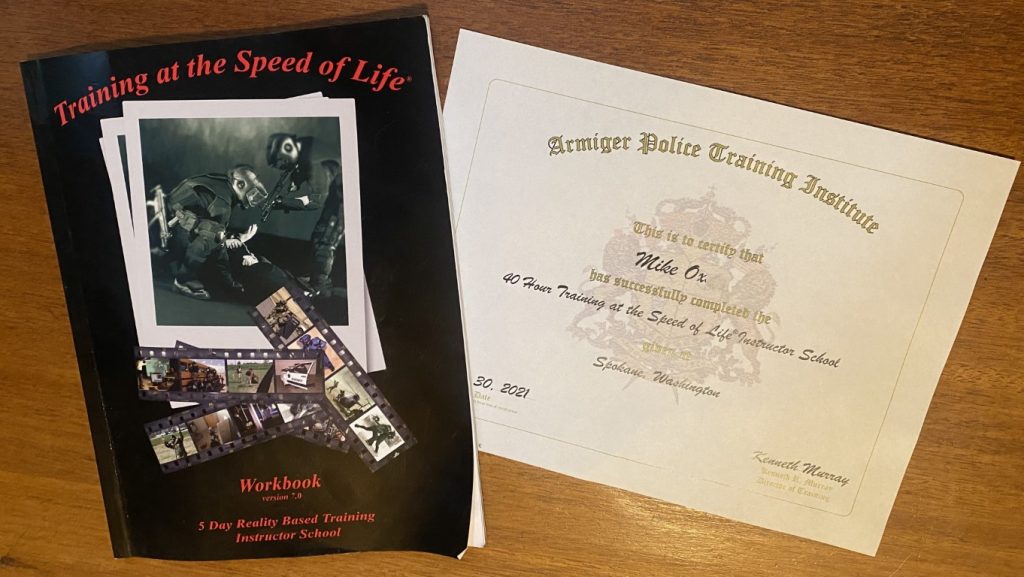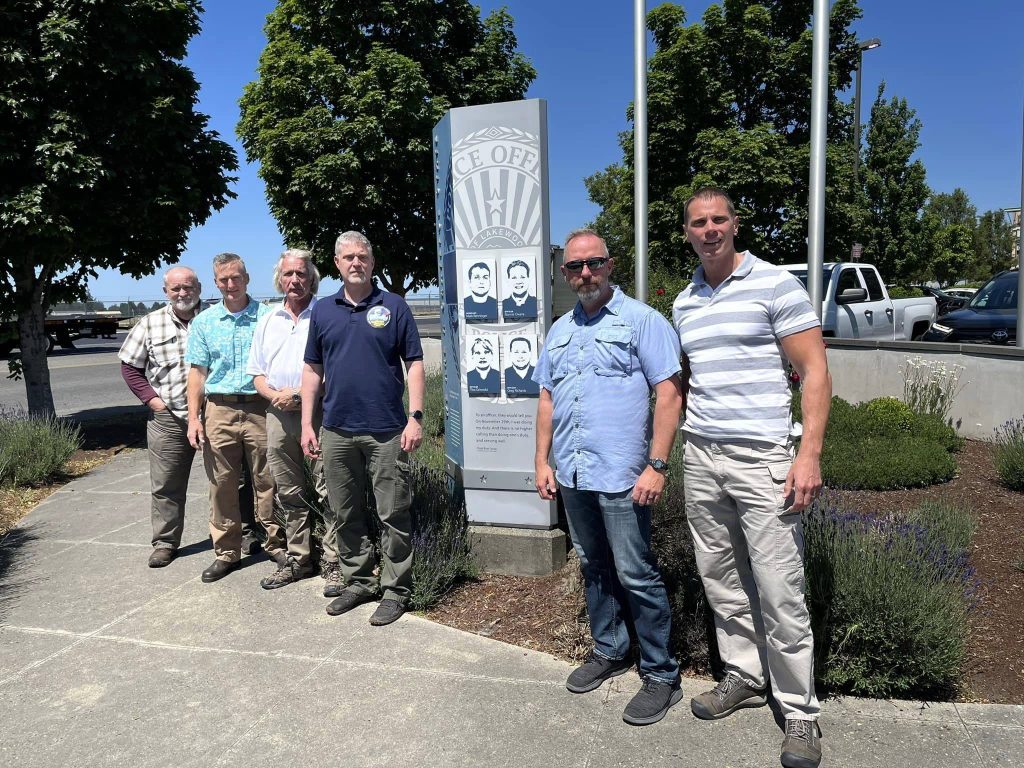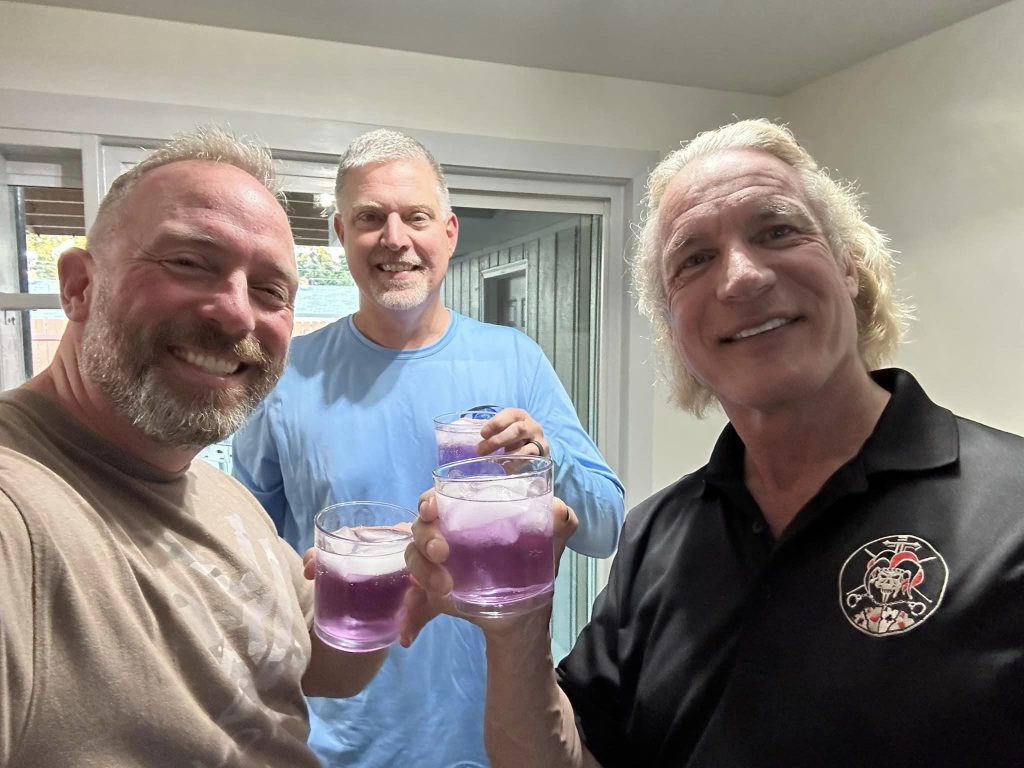I got to spend last week as an assistant instructor with Ken Murray teaching his “Training At The Speed Of Life” Reality Based Training instructor course. It’s a 5 day, 40 hour course that goes into training history, gunfight dynamics, how to safely structure and run reality based training, teaching/learning strategies, reality based training technologies, and more. Here’s my cert from when I went through it a couple of years ago. I’m now a master-instructor (instructor of instructors).

I originally connected with Ken about 10 years ago and we’ve become good friends since. Earlier this year, we spent 13+ hours in a car one day driving to and from Chris Graham’s memorial service…after 13+ hours in a car together, we STILL ended up solving the problems of the world until 5AM.
Ken only teaches instructors and his class is not simply a “force-on-force” experience, but rather instructor training for reality based training. That may or may not mean guns are drawn or fired.
If you haven’t read Ken’s book…you should. It’s not cheap, but my readers/patrons/clients tend to appreciate maximum value and this is a great example of that.
It’s good enough that I have 2 (TWO, not just 1) marked up and dog-eared copies of his book.
The book has dozens, if not hundreds of lessons learned from officers who survived gunfights, officers who did not win their gunfights, and lessons learned from people who have died doing reality based training incorrectly. Some of these lessons are almost impossible to anticipate, and if we don’t learn from the lessons that others shed blood to learn, it seems likely that we may pay a high price to learn them first hand.
In fact, in the back of the book, Ken has the summaries of the events that led to the death of 36 officers doing reality based training…this is important so we can create systems to avoid re-making catastrophic errors.
If you look at the last year of JUST law enforcement training incidents, there have been 7 accidental/negligent shootings and 5 fatalities. This is a super-big deal.
Below is part 1 of 2(?3?) of a machine-gun summary of wisdom from the week…some will be refreshers, but many will be exciting and new.
- “Train at the speed of success” One of the biggest problems with modern training is that people add speed to a technique before they have the skill necessary to perform the technique at speed. It’s important, especially early in the learning cycle, to go however slowly you need to go to have early success and continual success. This is important for both instructors and mostly self-taught shooters. >SLOW DOWN<
- “3 Drivers of Change” 1. We evolve as a person. 2. Psychotherapy. 3. Emotionally significant events. We can evolve through decisions, learning, and desire. Reality Based Training can provide emotionally significant events to drive quick, dramatic, step-function change…how it’s delivered determines whether that change is an enhancement or inhibitory and a big reason why this training is so important. A LOT of force-on-force training creates episodic, emotional memories instead of skill…and they create a sort of PRE-traumatic stress disorder where the simulated event makes people anxious (instead of confident) when they face something similar in the future.
- “4 ‘C’s of what-to-do-next in a gunfight: Think about 1. Cover, 2. Condition (your condition, gun’s condition, threat’s condition, etc.) Communication 4. Combat breathing.
This is something that MUST be practiced…and practiced with specificity. I have failed at this and I’ve seen numerous students fail at this.
- Knowing how to do something and being able to talk about it doesn’t mean you can do it under a little stress. There’s a video I’m going to be sharing with you that demonstrates dozens of people trying to ride a special bike. They know what they’re supposed to do, but as soon as a tiny bit of stress is added, they can’t ride the bike. In fact, in the last decade, NOBODY who has tried to ride this bike has been able to…despite knowing how. Head knowledge does not equal skill. And a tiny bit of stress causes our brain to skills we have performed rather than ones we only have head knowledge about.
- Students MUST be ready to learn. “Before I heal you, are you willing to give up the things that are making you sick?” -Hippocrates. A student who thinks they know everything is incredibly unlikely to learn or make the changes necessary to make those lessons stick.
- In “Reality Based Training” not all scenarios should require shooting or drawing. We want to be able to draw when we should draw…not draw when we shouldn’t. Shoot when we should shoot…not shoot when we shouldn’t. If reality based training has value and transfers to real life and every scenario is a shoot scenario, what is that priming students to do? How about your at-home training? Are you drawing to cover in addition to drawing and engaging? Are you practicing clearing cover and gripping, but not drawing? This has been a big change for me personally in the last few years.
- Importance of cover. If I understood this correctly, in the North Hollywood Shootout, 12 officers and 8 civilians were injured. 18 of them were injured by bullets. Only 1 of the 18 was injured by a direct hit…the other 17 were injured by ricochets and shoot-throughs.. This underscored the importance of proper cover. It’s not just a matter of conceptually knowing what cover is, but identifying it, moving to it, and actually shooting over/around it during training. (We’ll be covering this more)
- The importance of a deep-groove approach to learning skills, the challenge of slip and capture errors as you’re switching from an old skill to a new skill, and how long it takes to overwrite old skills and make a new one the default. (We’ll be covering this more)
- Tolley Curve. I’ll get into this more, if there’s interest, but it’s the idea that the path from beginner to expert is NOT a straight line for most students…it’s a curve where progress is slower initially as vocabulary and concepts are internalized, but the rate of progress/performance/learning accelerates over time. There are tie-ins here for why priming before training increases the amount of skills learned during training AND why people who recycle and go through elite training programs a 2nd or 3rd time tend to succeed at a very high rate and perform at a higher level long term.
- Flip Side of “Dunning Kreuger”. The Dunning Kreuger effect is what happens when people who have a taste of experience and minimal skill grossly overestimate their skill level. The flip side is that exceptional performers oftentimes aren’t aware of how good they are and they teach above the level of their students…thinking that if something is easy for them, it must be easy for everyone.
- 4 Options that Suspects have. Fight, flee, submit, posture/negotiate. That’s it…those are the only 4 options that suspects/attackers have. Ken goes into wonderful detail on this and the importance in his book.
- 4 Options that Officers have. Talk, fight, shoot, leave. Civilians have the option to submit/comply as well. (You can give a bad guy your wallet, or lay on the ground in a bank robbery)
- Airsoft ricochets with about 80% velocity. I knew this conceptually as “a lot” because I’ve had airsoft ricochets “get my attention” in training, but didn’t realize the numbers were so high. Practically, this means (roughly) that if you’re shooting at a target 5m away and it ricochets back at you, it’ll be similar to being shot from 20-25m away.
- Airsoft force-on-force requires the same protective equipment as sim rounds or paintball…namely eye, face, neck, top of head, hand, and groin protection. We reviewed numerous injuries from people who were under-protected while using airsoft and it was quite convincing.
- Groin protection is ESSENTIAL for projectile force-on-force training. A recent incident (not in Ken’s training) where an officer lost a testicle due to a training projectile highlights this need. If you knew just how little insurance companies and attorneys believe a testicle is worth, you’d be absolutely shocked.
- “Aim at the present, Shoot at the past, Hit the future”
- The story of Deputy Jennifer Fulford. Responding to a call, she encountered 2 suspects. She was shot 10 times and had 7 rounds hit flesh. Shooting hand got taken out. Fought with her other strong hand, including a reload, and decisively won the fight. Bullets are not magical and don’t necessarily stop bad guys or good guys as quickly as portrayed. It’s important to NOT train to stop fighting after being hit once…it’s important to train to make sure that, if we have to shoot, that we stop the threat before thinking the fight is over.
- People can not consolidate new memories other than emotional, episodic memories when the brain is experiencing anxiety. This leads into the importance of creating scenarios, drills, AND DIY at-home practice sessions that are a little bit of a stretch, but within your ability and not so far beyond your ability that they create anxiety.
- When people are faced with fear, they either respond with confidence or anxiety…we want the training that we do to replicate as many factors of reality as possible so that when we face a real-world situation that induces fear, we’ll be as comfortable and confident as possible rather than anxious and afraid about the sheer volume of new things we’re dealing with.
- Impact of Training. In the late 80s, the LE hit percentage was less than 15% at 10 feet. Today, for officers who are actually trained beyond POST standards, it’s 92%.
- Cost of shots fired by officers. $10k for each shot fired in public. $25k for each shot that hits something. $50k for each shot that hits someone.

There were 3 of us assisting Ken this week…Jeff Johnsguard, Dan Fraser, and myself. Jeff and Dan are current & former Calgary PD and teach the Methods of Instruction class for Force Science.
They are brothers from another mother and it was great spending the week with them and learning from them all.

I am absolutely honored to be a master instructor and running classes with Ken. If you are interested in having Ken and I come out and run an instructor development course for reality based training for your agency, unit, or training organization, email me or comment below.
EVERY instructor who has gone through the training…from newbies to military Tier I from around the globe…has been shocked at how much they didn’t know and amazed at how lucky they’d been and that they hadn’t had major accidents or fatalities in training.
It truly is a transformative class.
From safety procedures to make sure everyone goes home with the same amount of holes as they arrive with…
To neurological and accelerated learning techniques to help your students build more skill in less time…
To scenario planning strategies that maximize learning speed and minimize training scars.
Again, reach out if you’re an instructor and want to get this training for yourself and your fellow instructors.
That brings me to the gap between traditional static range training and the reality of both Reality Based Training and real-world self-defense…it’s HUGE.
Traditional ranges and traditional training don’t address this very well. Most ignore it. Those that don’t ignore it use a learning process that’s excessively expensive and time consuming.
And that combination of expense and time puts real-world skills out of the reach of the common gun owner.
That shouldn’t be—you deserve better.
It’s part of why I created Dynamic Gunfight training…
Ironically, it was an elite military training command that asked me to make the pistol portion of their training more effective, but it’s because they weren’t getting the time and resources they needed to get the job done using old teaching/training methods. And that probably sounds familiar, doesn’t it?
They needed something that worked quicker…that would allow them to get better results in less time and for the same or less money than what they were currently spending on training.
And, so do you.
That’s why I want to encourage you to do one of 2 things…
- Watch our free Gunfight Training presentation >HERE< and sign up for the step-by-step training that’s offered at the end.
- If you’ve already attended the full presentation but haven’t signed up yet, watch the summary version >HERE< (same link as above) and sign up for the step-by-step training that’s offered at the end today.
It will take you on a journey where, in just 10 hours spread out over the next 6 weeks…in 5-15 minute chunks of at-home dry fire training, you’ll develop top 10% or even top 1% self-defense gun fighting skills for a tiny fraction of what it would cost using traditional methods.
There’s no other training, tool, tech, or gadget you can get and use in the next 6 weeks that will come close to delivering the same amount of dynamic gun fighting skill as this training, regardless of the cost or time that you spend using them.
To be very, very clear, it is not a replacement for reality based training.
It is training to help you build as many real-world gunfight skills as possible–at home–so that you’re able to perform better and learn more in a reality based training class AND so that you can perform better in a real-world assault/ambush situation…where lives may depend on your ability to perform in a context that’s wildly different than what’s allowed at your local range.
So…check out the free presentation, and sign up for the full 6 week training at the end by clicking >HERE< now.
Questions? Comments? Want to dig into any more of the snippets above? Fire away by commenting below.
“Don’t just train hard. Train smarter than the other guy!”
-Ox

8 Comments
Alan Kerby
June 17, 2023Ox,
Thanks for the article. Looking forward to more information on the training. Can you provide a reference for your comment: “Today, for officers who are actually trained beyond POST standards, it’s 92%?” Thanks.
Alan
Ox
June 19, 2023I asked Ken…it came from Police Marksman Association and we’re trying to track down the original quote.
rod vanzeller
June 16, 2023Did you measure heart rate and cortisol levels during training?
Ox
June 17, 2023Not this time, although it’s been done in the past.
In the past, these have been red herrings because heartrate from exertion has a different impact on performance than heartrate from a sympathetic response.
More importantly you can SEE the stress response in the form of slip-n-capture errors, goofy loops, big drops in performance of un-automated skills, and other visible indications that are consistent between scenario training and real life.
Robert Hankins
June 16, 2023OX,
So are we going to get specifics so we can do this training correctly on our own ?
Ox
June 17, 2023Yes. The short answer is that the 5 day course teaches instructors how to safely and effectively lead reality based training and/or Ken and I can come out and run classes for people. When people try to shortcut the process, a few HUGE classes of problems happen:
1. they end up with a swiss-cheese approach to safety that inevitably lets bullets through. We don’t want that. As an example, most force on force safety checks are done using the process of “check yourself” and “check your buddy” which are both 80%-90% solutions. We use metal detectors and a very specific searching process that is quicker and more effective as demonstrated by the track record over the last 35 years.
2. traditional force on force training ends up being haphazard and not geared towards a specific outcome that has transfer to the real world.
3. traditional force on force training tends to be either under-stimulating or scarring in it’s intensity. There are processes we use to alter the stress of scenarios…like a volume knob…in real time that allow the exercise controller to customize the scenario to the student in real time.
If you want to host instructor training or scenario training, let me know.
Ron Flowers
June 16, 2023I have been a huge fan of Ken’s book for years, and have incorporated may principles gleaned from it in training I conduct for my own comp[any, as well as my work as a Staff Instructor for the NRA LE Div and NLEFIA. Please point me to a schedule of the above described 5-day class, as I would love to attend one!
Than ks!
Ox
June 17, 2023Hey Ron, I’m going to be talking with MM this week about the possibility of doing instructor training for NLEFIA.
The majority of the instructor training classes are closed enrollment that are paid for by a single agency/unit and they are then able to invite neighboring personnel, if they wish. Open enrollment classes are rare, but we’re working on an option because of demand.
Leave A Response